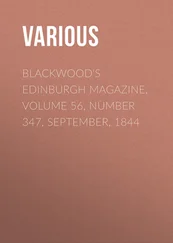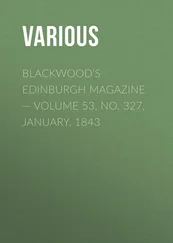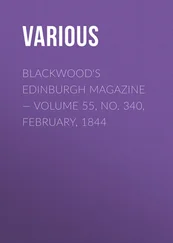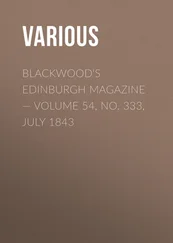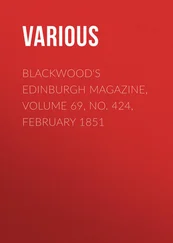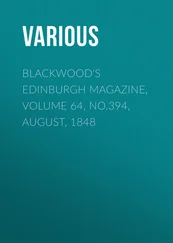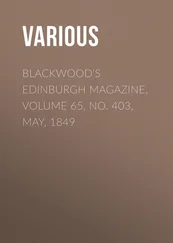Various - Blackwood's Edinburgh Magazine, Volume 58, No. 359, September 1845
Здесь есть возможность читать онлайн «Various - Blackwood's Edinburgh Magazine, Volume 58, No. 359, September 1845» — ознакомительный отрывок электронной книги совершенно бесплатно, а после прочтения отрывка купить полную версию. В некоторых случаях можно слушать аудио, скачать через торрент в формате fb2 и присутствует краткое содержание. Издательство: Иностранный паблик, Жанр: periodic, foreign_edu, Путешествия и география, на английском языке. Описание произведения, (предисловие) а так же отзывы посетителей доступны на портале библиотеки ЛибКат.
- Название:Blackwood's Edinburgh Magazine, Volume 58, No. 359, September 1845
- Автор:
- Издательство:Иностранный паблик
- Жанр:
- Год:неизвестен
- ISBN:нет данных
- Рейтинг книги:4 / 5. Голосов: 1
-
Избранное:Добавить в избранное
- Отзывы:
-
Ваша оценка:
- 80
- 1
- 2
- 3
- 4
- 5
Blackwood's Edinburgh Magazine, Volume 58, No. 359, September 1845: краткое содержание, описание и аннотация
Предлагаем к чтению аннотацию, описание, краткое содержание или предисловие (зависит от того, что написал сам автор книги «Blackwood's Edinburgh Magazine, Volume 58, No. 359, September 1845»). Если вы не нашли необходимую информацию о книге — напишите в комментариях, мы постараемся отыскать её.
Blackwood's Edinburgh Magazine, Volume 58, No. 359, September 1845 — читать онлайн ознакомительный отрывок
Ниже представлен текст книги, разбитый по страницам. Система сохранения места последней прочитанной страницы, позволяет с удобством читать онлайн бесплатно книгу «Blackwood's Edinburgh Magazine, Volume 58, No. 359, September 1845», без необходимости каждый раз заново искать на чём Вы остановились. Поставьте закладку, и сможете в любой момент перейти на страницу, на которой закончили чтение.
Интервал:
Закладка:
"In art," says Constable, writing in 1829, "there are two modes by which men aim at distinction. In the one, by a careful application to what others have accomplished, the artist imitates their works, or selects and combines their various beauties; in the other, he seeks excellence at its primitive source, nature. In the first, he forms a style upon the study of pictures, and produces either imitation or eclectic art; in the second, by a close observation of nature, he discovers qualities existing in her which have never been portrayed before, and thus forms a style which is original. The results of the one mode, as they repeat that with which the eye is already familiar, are soon recognised and estimated; while the advances of the artist on a new path must necessarily be slow – for a few are able to judge of that which deviates from the usual course, or are qualified to appreciate original studies ." In this passage is contained, both the principle of Constable's painting, and the history of its results: for, strange as it may seem, so little do general observers look at nature with an observing and pictorial eye – so much are their ideas of what it contains received at second-hand, by reflection from pictures – that the forms under which artists have combined to represent her (forms representing, it may be, a portion of the truth, but certainly not the whole truth) have, in the great majority of cases, superseded the stamp and authority of nature; and truth itself, where it did not steal in under a conventional garb, has been refused admittance by more than one committee of taste. "What a sad thing," Constable writes to Leslie, "that this lovely art is so wrested to its own destruction! Used only to blind our eyes, and to prevent us from seeing the sun shine, the fields bloom, the trees blossom, the foliage rustle; while old black rubbed-out and dirty canvasses take the place of God's own works!"
With his mind made up as to the course to be adopted, Constable betook himself to the study of nature on the spot. Careful drawing was his first object, as the substance to which the embodiment of colour and chiaroscuro was to be applied, and without which, though there might be effect, there could be no truth. His studies of trees and foreground are said to have been eminently beautiful. These, however, he loved to exhibit in their vernal, rather than their autumnal character. "I never did admire the autumnal tints, even in nature – so little of a painter am I in the eye of common connoisseurship. I love the exhilarating freshness of spring." Buildings he did not court, but rather avoided – though in later life he grappled successfully even with architectural detail, as in his pictures of Salisbury Cathedral; 2 2 Even there we see that he viewed the matter as a task, and piqued himself only on having succeeded in a tour-de-force . Writing to Archdeacon Fisher, he says – "It was the most difficult subject in landscape I ever had on my easel. I have not flinched at the windows, buttresses, &c.; but I have still kept to my grand organ, colour, and have as usual made my escape in the evanescence of chiaroscuro." – (P. 109.)
but, in general, he dealt with it sparingly. Shipping and coast-scenes he considered "more fit for execution than for sentiment." What he luxuriated in was the study of atmospheric effects, and the principles of light and shadow as applied to his sylvan and pastoral landscapes. "I hold the genuine pastoral feeling of landscapes," said he, writing in 1829 to his friend Archdeacon Fisher, "to be very rare, and difficult of attainment. It is by far the most lovely department of painting, as well as of poetry." "Painting," he says in another letter, "is with me but another word for feeling, and I associate my careless boyhood with all that lies on the banks of the Stour. These scenes made me a painter, and I am grateful." "Whatever may be thought of my art, it is my own; and I would rather possess a freehold, though but a cottage, than live in a palace belonging to another."
Thus feeling intensely the charm of nature – and confident that by the vivid representation of pastoral English landscape, he could enable it to exercise upon other minds something of the same spell which it produced on his own – his whole efforts, as he says himself, were directed to forget pictures, and to catch if possible the precise aspect which the scenery which he endeavours to portray presented at the moment of study. And here particularly it is, that the genius of Constable is visible. A man of less reach of mind, beginning, as he did, with this minute attention to the vocabulary of detail, would probably have ended there. We should have had a set of pictures perfectly painted in parts, but forming no consistent whole. All general effect would have been sacrificed to the impression to be produced by particulars. The very love of nature often leads to this error – as in the once-popular Glover, and many others. But no one had a fuller sense than Constable, that by this means pictures never can be created; that literal imitation of the details of nature is a delusion; because not only is the medium we use entirely inadequate, but paint as we may, with the most microscopic minuteness of detail, the thousand little touches and reflexes of light and shade, which soften and harmonize all things in nature, are essentially evanescent, and incapable of being transferred to canvass. He felt that a certain substitute for nature, awakening a corresponding impression upon the mind, was all that he could be afforded by painting – that the spirit and not the letter of her handwriting was to be imitated. The object of painting, as he himself expressed it, "was to realize, but not to feign: to remind, but not to deceive."
Hence, while he perfectly succeeded in catching the spirit of the spot – so much so, that Mr Leslie, visiting the scenes of his pictures for the first time after his death, declares, "that he was absolutely startled by the resemblance" – he yet exercised over the whole that creative, at least compounding art, which arrayed the objects in the forms most harmonious to the eye, and grouped the details into a whole, telling in the most effective manner the story, or conveying the impression it was intended to create. The composition of a picture, he used to say, "was like a sum in arithmetic – take away, or add the smallest item, and the whole was certain to be wrong."
As a consequence, we think, of this conviction, that nature is not to be literally imitated in her colours or forms, but that some compromise is to be found, by which, though on a lower key, a similar impression is to be made on the eye, and through that on the mind, is the general abstinence from positive colour, which distinguishes Constable's paintings. It was not that he adopted the conventional orange and brown of the continental school, or shrank from endeavouring to carry the full impression of the dewy verdure of English landscape. For these subterfuges in art he had an abundant contempt. "Don't you find it very difficult to determine," said Sir George Beaumont, (who, with all his fine feelings of art, certainly looked at nature through a Claude Lorraine medium,) "where to place your brown tree ?" "Not in the least," was Constable's answer, "for I never put such a thing into a picture." On another occasion, when Sir George was recommending the colour of an old Cremona fiddle as a good prevailing tone for every thing, Constable answered the observation by depositing an old Cremona on the green lawn in front of the house at Cole-Orton. But what we mean is this – that to produce the effect which green or red produces in nature, it does not follow that green or red are to be used in art, and that the impression of these colours will often be better brought out by tints in which but a very small portion of either is to be found.
Читать дальшеИнтервал:
Закладка:
Похожие книги на «Blackwood's Edinburgh Magazine, Volume 58, No. 359, September 1845»
Представляем Вашему вниманию похожие книги на «Blackwood's Edinburgh Magazine, Volume 58, No. 359, September 1845» списком для выбора. Мы отобрали схожую по названию и смыслу литературу в надежде предоставить читателям больше вариантов отыскать новые, интересные, ещё непрочитанные произведения.
Обсуждение, отзывы о книге «Blackwood's Edinburgh Magazine, Volume 58, No. 359, September 1845» и просто собственные мнения читателей. Оставьте ваши комментарии, напишите, что Вы думаете о произведении, его смысле или главных героях. Укажите что конкретно понравилось, а что нет, и почему Вы так считаете.

